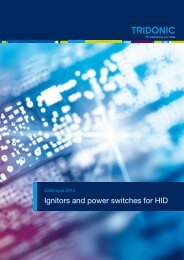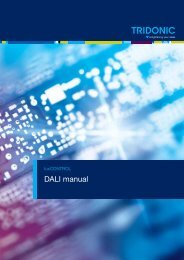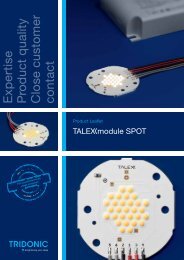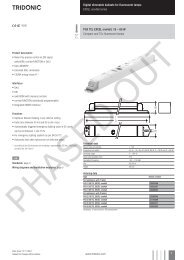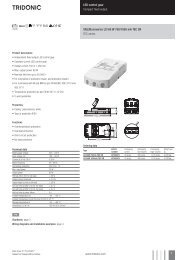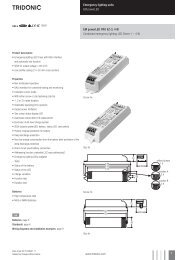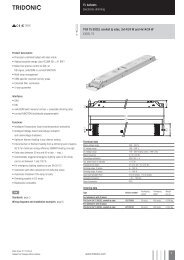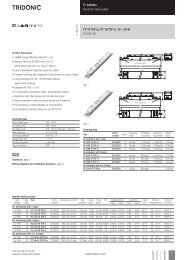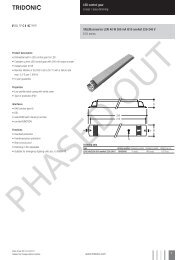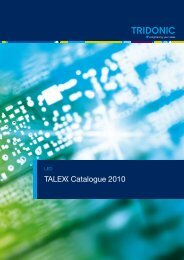Create successful ePaper yourself
Turn your PDF publications into a flip-book with our unique Google optimized e-Paper software.
Emergency lighting units<strong>EM</strong> seriesStandards• according to EN <strong>50</strong>172• according to EN <strong>60</strong>598-2-22• EN 61347-2-7• EN <strong>60</strong>925• EN 5<strong>50</strong>15• EN 61000-3-2• EN 61000-3-3• EN 61547• EN <strong>60</strong>068-2-64• EN <strong>60</strong>068-2-29• EN <strong>60</strong>068-2-30Isolation and electric strength testing of luminairesElectronic devices can be damaged by high voltage. This has to be consideredduring the routine testing of the luminaires in production.According to IEC <strong>60</strong>598-1 Annex Q (informative only!) or ENEC 303-Annex A, eachluminaire should be submitted to an isolation test with <strong>50</strong>0 VDC for 1 second. Thistest voltage should be connected between the interconnected phase and neutralterminals and the earth terminal. The isolation resistance must be at least 2 MΩ.As an alternative, IEC <strong>60</strong>598-1 Annex Q describes a test of the electrical strengthwith 1,<strong>50</strong>0 VAC (or 1,414 x 1,<strong>50</strong>0 VDC). To avoid damage to the electronic devicesthis test must not be conducted.Batteries NiCdCase temperature range 0 °C to +55 °Cto ensure 4 years design lifeBattery voltage/cell1.2 VCapacity4.0 AhMax. short term temperature (reduced lifetime) 70 °CPacking quantity5 pcs. per cartonConnection method: 4.8 x 0.5 mm spade welded to end of cellFor the stick batteries this connection is accessible after the battery end capshave been fitted.To inhibit inverter operation, only disconnect the batteries by removing the connectorfrom the battery spade tags.Electrical connectionsAn earthed starting aid is recommended.The module should be earthed by the fixings used to attach it to the luminaire.Terminal block type:Push wire and insulation displacementTerminal block capacity• Push wire: 0.5 to 1.5 mm 2 solid conductor• Insulation displacement: 0.5 mm 2 solid conductorWire strip length: 9 to 10 mmLamp lead length: 2,<strong>50</strong>0 mm max.The longer pair of leads should always be connected to terminals 3 and 8.CE markingThe modules are CE marked for compliance with the low voltage directive.Certificates of compliance are available to allow luminaires to be CE marked forcompliance with the <strong>EM</strong>C directive.Mechanical detailsChannel manufactured from 0.4 mm Galvatite galvanised steel.Cover manufactured from 0.4 mm white precoated steel.LED status indicator• Green• Mounting hole 6.5 mm diametre• Lead length 7<strong>50</strong> mm (Bezel supplied fitted to LED)• Insulation rating: 90 °CTest switch• Mounting hole 7 mm diametre• Length of test switch lead 5<strong>50</strong> mmBattery leads• Quantity: 1 red and 1 black• Length: 1000 mm (Accu NiCd 4B, 4C), 1300 mm (all others)• Wire type: 0.5 mm 2 solid conductor• Insulation temperature rating: 90 °CTermination 1Push on 4.8 mm receptacle to suit battery spade fitted with insulating coverTermination 29 mm stripped insulationTwo-piece batteries are supplied with a 200 mm lead with 4.8 mm receptacle ateach end and insulting covers to connect the separate sticks together.Wiring guidelinesTo ensure that a luminaire containing high frequency emergency units complieswith EN 5<strong>50</strong>15 for radio frequency conducted interference in both normal andemergency mode it is essential to follow good practice in the wiring layout.Within the luminaire the switched and unswitched <strong>50</strong> <strong>Hz</strong> supply wiring must berouted as short as possible and be kept as far away as possible from the lampleads.This means, for example, in a linear T8 luminaire the mains wiring shouldbe routed along one side of the luminaire body, while the wires to the emergencylamp from the emergency module are routed along the other side.The high frequency emergency lamp wiring contains “hot” leads at pins 1 and 6,which have high voltage to earth. These should be kept as short as possible andseparated from other wiring to minimize coupling. They also have a restrictionon capacitance to other wiring and earth of 100 pF, which must be observed toensure good lamp starting.With an earth connection of the metal case of the emergency module the noisesuppression can be further improved. The wiring of the earth should be kept asshort as possible.Through wiring may affect the emc performance of the luminaire.With the use of the fifth pole possible compatibility problems between the productscan be prevented. Depending on the luminaire wiring the radio suppressionin the emergency mode of operation can be further improved.Capacitive loading limits of lamp leads must not be exceeded. Note the capacitanceof the emergency lamp leads adds to the capacitance of the leads fromthe ballast to the <strong>EM</strong> <strong>BASIC</strong> module when considering ballast loading.Service lifeAverage service life <strong>50</strong>,000 hours under rated conditions with a failure rate lessthan 10 %. Average failure rate of 0.2 % per 1,000 operating hoursData sheet 06/12-589-2Subject to change without notice.www.tridonic.com 4





